HISTORIC COVENTRY CATHEDRAL FIRESTORM VICTIM
Coventry, England · November 14, 1940
On this date in 1940 the first firestorm of the war was inflicted on Coventry, England, a city of almost 240,000 people, during the German Blitz against that country. German “pathfinder” bombers flying along radio-direction beams targeted the medieval cathedral city and industrial-munitions center in the English Midlands. Nearly 450 bombers rained more than 500 tons of high-explosive bombs and some 56 tons of incendiary bombs (that is, 30,000 incendiary bombs!) over ten hours on a moon-bright night.
The raging inferno, spreading quickly due to the existence of so many of Coventry’s ancient and closely built timber-framed buildings, destroyed or damaged 80 percent of the city center, including its cathedral, and about three-quarters of the city’s factories. Apart from the cathedral and city factories, two hospitals, two churches, hotels, clubs, movie houses, public shelters, public swimming pools, a police station, and a post office were also bomb targets. Killed were 568 civilians who were laid to rest in two mass burials spread over a two-week period (it took that long to recover all the bodies); over 1,200 people were badly wounded.
Berlin was giddy over its firebombing success. The official German news agency crowed that the raid on Coventry, codenamed Operation Midnight Sonata, was “the most severe in the whole history of the war.” Germans created a new word for the type of destruction they inflicted on the city, koventrieren (Coventrate). Yet the English Midlands city quickly recovered from its ordeal, and within days most of Coventry’s factories were up and running. It became a point of pride, an indication of the national mood, that morale recovered so quickly as well. Small signs sprouted in broken shop windows, announcing “Business as usual.” By Christmas 1940 the firebombing raids covered most of Britain’s major cities: Glasgow in Scotland, Belfast in Northern Ireland, the port of Liverpool, and Sheffield deep in the heart of England were all badly hit. Just before New Year’s 1940, 130 bombers attacked London, nearly setting St. Paul’s Cathedral ablaze, but the surrounding areas of ancient buildings and churches representing hundreds of years of history were lost.
As the European and Pacific theaters showed right up through August 1945, combatant populations had a tremendous ability to suffer violence and bleak futures without losing their will to sustain the war effort. Only the atomic bombings of Hiroshima and Nagasaki in Japan changed their leaders’ minds.
[amazon_carousel widget_type=”ASINList” width=”600″ height=”200″ title=”Recommended Reading” market_place=”US” shuffle_products=”False” show_border=”False” asin=”0007386613,030435676X,0747808295,1441185682,0713995610,0300125569,0752451723,071532554X,0199574413,1849084246″ /]
Coventry, England, After the Blitz of November 14/15, 1940
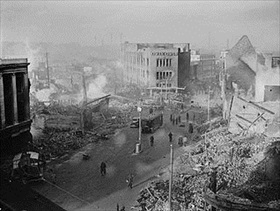 | 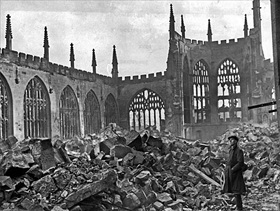 |
Left: Broadgate in Coventry city center on November 16, 1940, following the 10‑hour Coventry Blitz during the night of November 14/15. The burnt-out shell of the Owen department store (middle), opened in 1937, overlooks a scene of devastation.
![]()
Right: The provost of Coventry Cathedral, also known as St. Michael’s Cathedral, and a party of helpers attempted to deal with the first set of incendiary bombs that burst through the cathedral roof and walls by smothering the flames with sand. But another shower of incendiaries accompanied by high explosives, oil bombs, and land mines forced the party to give up its efforts. By the next morning only the skeleton of the cathedral was left standing.
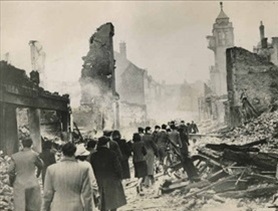 | 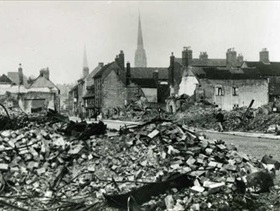 |
Left: This was an official U.S. press photograph, showing the rest of the world what the Luftwaffe had done to Coventry—in this scene, Earl Street as seen from Jordan Well. The stream of people attempting to go to work the next day, picking their way through the rubble, highlighted perfectly the point that the world’s press wanted to make, namely, the Germans could not bomb the British into submission. The Council House clock tower is clearly visible through the haze of smoke, and although the building had virtually all its windows blown in by bomb blasts, it survived the night of November 14/15 remarkably unscathed.
![]()
Right: Very little remained of Little Park Street by November 15 after the houses and small factories in that street formed one continuous raging inferno. This photo, taken some weeks after the raid, shows Holy Trinity Church spire (right in background), which was previously undetectable through the haze of smoke.
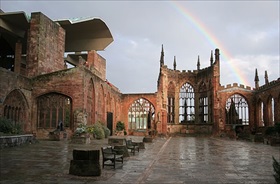 | 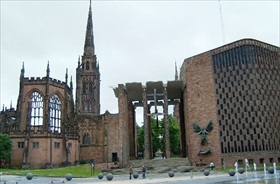 |
Above: The ruins of the old Coventry Cathedral, the most visible modern-day reminder of the Blitz. A new cathedral was constructed alongside the ruins in the 1950s, designed by the Scottish architect Basil Spence. Later knighted for this work, Spence insisted that instead of rebuilding the old Anglican cathedral it should be kept in ruins as a garden of remembrance and that the new cathedral should be built alongside—the two buildings together effectively forming one church. The cathedral was reconsecrated on May 25, 1962.
The Overnight Bombing of Coventry, November 14/15, 1940, and the Rebirth of Its Cathedral
![]()

 History buffs, there is good news! The Daily Chronicles of World War II is now available as an ebook for $4.99 on Amazon.com. Containing a year’s worth of dated entries from this website, the ebook brings the story of this tumultuous era to life in a compelling, authoritative, and succinct manner. Featuring inventive navigation aids, the ebook enables readers to instantly move forward or backward by month and date to different dated entries. Simple and elegant! Click
History buffs, there is good news! The Daily Chronicles of World War II is now available as an ebook for $4.99 on Amazon.com. Containing a year’s worth of dated entries from this website, the ebook brings the story of this tumultuous era to life in a compelling, authoritative, and succinct manner. Featuring inventive navigation aids, the ebook enables readers to instantly move forward or backward by month and date to different dated entries. Simple and elegant! Click 











